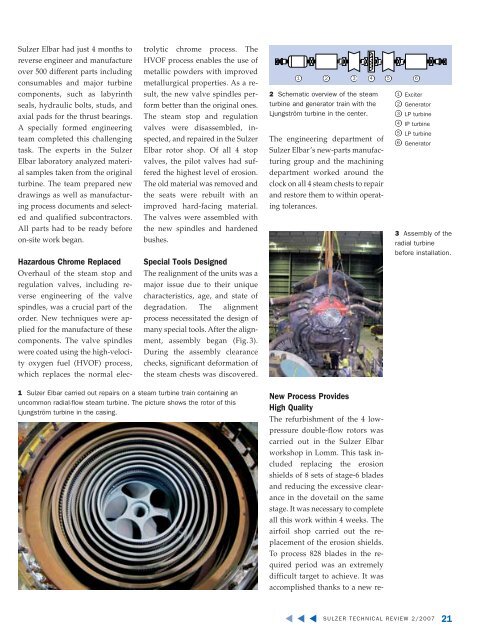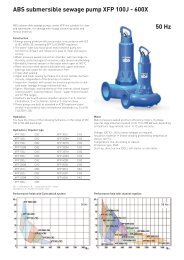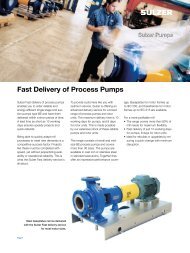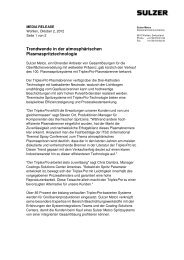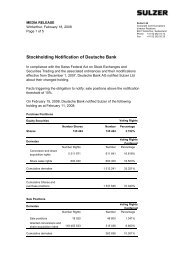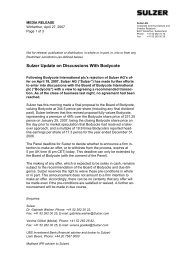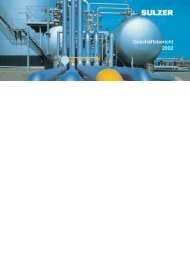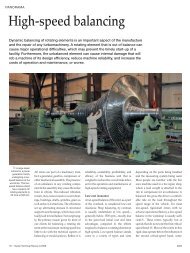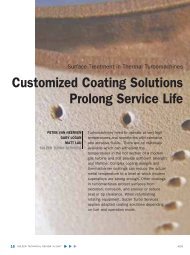HAN HAMER SULZER TURBO SERVICES Repairing and performing
HAN HAMER SULZER TURBO SERVICES Repairing and performing
HAN HAMER SULZER TURBO SERVICES Repairing and performing
You also want an ePaper? Increase the reach of your titles
YUMPU automatically turns print PDFs into web optimized ePapers that Google loves.
Sulzer Elbar had just 4 months to<br />
reverse engineer <strong>and</strong> manufacture<br />
over 500 different parts including<br />
consumables <strong>and</strong> major turbine<br />
components, such as labyrinth<br />
seals, hydraulic bolts, studs, <strong>and</strong><br />
axial pads for the thrust bearings.<br />
A specially formed engineering<br />
team completed this challenging<br />
task. The experts in the Sulzer<br />
Elbar laboratory analyzed material<br />
samples taken from the original<br />
turbine. The team prepared new<br />
drawings as well as manufacturing<br />
process documents <strong>and</strong> selected<br />
<strong>and</strong> qualified subcontractors.<br />
All parts had to be ready before<br />
on-site work began.<br />
Hazardous Chrome Replaced<br />
Overhaul of the steam stop <strong>and</strong><br />
regulation valves, including reverse<br />
engineering of the valve<br />
spindles, was a crucial part of the<br />
order. New techniques were applied<br />
for the manufacture of these<br />
components. The valve spindles<br />
were coated using the high-velocity<br />
oxygen fuel (HVOF) process,<br />
which replaces the normal elec-<br />
trolytic chrome process. The<br />
HVOF process enables the use of<br />
metallic powders with improved<br />
metallurgical properties. As a result,<br />
the new valve spindles perform<br />
better than the original ones.<br />
The steam stop <strong>and</strong> regulation<br />
valves were disassembled, inspected,<br />
<strong>and</strong> repaired in the Sulzer<br />
Elbar rotor shop. Of all 4 stop<br />
valves, the pilot valves had suffered<br />
the highest level of erosion.<br />
The old material was removed <strong>and</strong><br />
the seats were rebuilt with an<br />
improved hard-facing material.<br />
The valves were assembled with<br />
the new spindles <strong>and</strong> hardened<br />
bushes.<br />
Special Tools Designed<br />
The realignment of the units was a<br />
major issue due to their unique<br />
characteristics, age, <strong>and</strong> state of<br />
degradation. The alignment<br />
process necessitated the design of<br />
many special tools. After the alignment,<br />
assembly began (Fig. 3).<br />
During the assembly clearance<br />
checks, significant deformation of<br />
the steam chests was discovered.<br />
1 Sulzer Elbar carried out repairs on a steam turbine train containing an<br />
uncommon radial-flow steam turbine. The picture shows the rotor of this<br />
Ljungström turbine in the casing.<br />
1 2 3 4 5 6<br />
2 Schematic overview of the steam<br />
turbine <strong>and</strong> generator train with the<br />
Ljungström turbine in the center.<br />
The engineering department of<br />
Sulzer Elbar’s new-parts manufacturing<br />
group <strong>and</strong> the machining<br />
department worked around the<br />
clock on all 4 steam chests to repair<br />
<strong>and</strong> restore them to within operating<br />
tolerances.<br />
New Process Provides<br />
High Quality<br />
The refurbishment of the 4 lowpressure<br />
double-flow rotors was<br />
carried out in the Sulzer Elbar<br />
workshop in Lomm. This task included<br />
replacing the erosion<br />
shields of 8 sets of stage-6 blades<br />
<strong>and</strong> reducing the excessive clearance<br />
in the dovetail on the same<br />
stage. It was necessary to complete<br />
all this work within 4 weeks. The<br />
airfoil shop carried out the replacement<br />
of the erosion shields.<br />
To process 828 blades in the required<br />
period was an extremely<br />
difficult target to achieve. It was<br />
accomplished thanks to a new re-<br />
1 Exciter<br />
2 Generator<br />
3 LP turbine<br />
4 IP turbine<br />
5 LP turbine<br />
6 Generator<br />
3 Assembly of the<br />
radial turbine<br />
before installation.<br />
<strong>SULZER</strong> TECHNICAL REVIEW 2/2007 21


